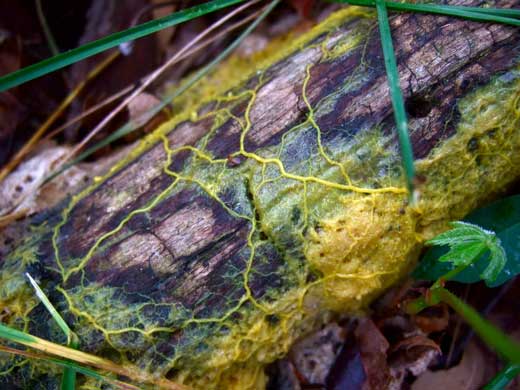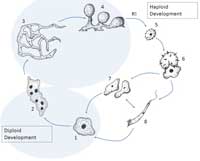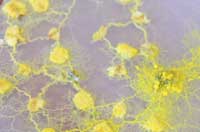Supporting materials
Download
Download this article as a PDF

These simple but unusual life forms can be used to develop students’ understanding of life and the scientific method.

Moving red or yellow slime might sound like something from a 1950s science fiction movie, but scientists often use slime moulds as model organisms to study cell motility, growth and differentiation (Montag, 2008).
Slime moulds (Eumycetozoa) are one of the most diverse genera known to man. Because of their variety, it is hard to classify them and the classification system itself changes every few years. It is not even clear what other group of organisms they belong to: their fruiting bodies resemble those of real fungi, but their genetics show they are more closely related to flagellates and amoebae (Hoppe & Kutschera, 2010).
There are more than 1000 species of real slime moulds (subclass Myxomycetes), and each organism is made up of just one cell. They are adapted to all sorts of environments and feed on other micro-organisms or detritus.
Physarum polycephalum is the most well known species of Myxomycetes and is an easy-to-use organism for demonstrating many basic biological processes.

The macroscopic form of the slime mould, called a plasmodium, constantly moves around in search of food; once Physarum has found it, it will engulf the particles or micro-organisms, creating food vacuoles that are then digested within the cell (Esser, 1976). This process is called phagocytosis.
If Physarum’s environment becomes too dry, it changes into a more resistant form to enable the mould to survive long periods of drought. Once the conditions improve, the mould can redevelop into a normal plasmodium. Environmental influences such as constant light or food shortage, however, prompt Physarum to develop fruiting bodies. Figure 1 shows the development cycle of a slime mould.
The project described here spans two lessons for students aged 16–19. The unit’s design is derived from the scientific method and has been divided into three phases: the introduction phase (theoretical background), the working phase (practice), and the evaluation and presentation phase.
Begin by showing your students a Physarumculture. The students can examine the mould in small groups with magnifying glasses in order to note down its main characteristics. Collect their results as a mind map on the board, with the centre being Physarum polycephalum.
You can also show a film depicting the life cycle of the slime mould, for example from YouTubew1. Since the video shows the movement of the cell, which appears to be directional, you can ask students how they think the mould could orientate itself. Note down the question and a few answers on the board.
Whenever the students start one of the experiments described below, make sure they first note down hypotheses regarding its expected result. For each experiment, the students should note down what they do and the results on their worksheets. This makes for better information retention and keeps them on track. At the end of the unit, collect the results and discuss them in class, finally answering the hypotheses that the students originally suggested. As most of the experiments described above take some time to finish, the evaluation and presentation are done in the second double period.
The results obtained in the chemotaxis and phototaxis experiments described here can be recorded on the worksheet ‘Creeping slime’w2

Physarum find food and avoid harmful conditions by moving in response to chemical stimuli – a process known as chemotaxis. In this lesson, small groups of students investigate the effect of chemoattractants and repellents. One half of the class studies the positive type while the other half studies the negative.
Place a chemical stimulus 1.5 cm away from a plasmodium in a Petri dish. For positive chemotaxis, use an oat flake; for negative chemotaxis, drop some vinegar onto the flake. Cover the whole plate with a thin film of distilled water and keep it in a dark place for some time at room temperature.
After some time, take the Petri dishes out and measure the distance between the mould and the oat flake.
The plasmodium will have moved towards the positive stimulus – the oat flake. Thick canals will be visible within the cell, transporting the fresh nutrients to every part of the organism. Meanwhile, in the other experiment, the mould will have moved away from the negative stimulus – the oat flake soaked in vinegar.
The results of the experiment suggest that Physarum must have chemoreceptors, as the environment was completely dark. They also show that the mould is able to measure differences in concentration because it moved to the food source directly: if more receptors are activated on one side of the cell, it knows where the concentration is higher. These receptors induce a signal transduction chain in the cell, which ultimately leads to the migration of the cell.
The experiment can be extended into an experiment of choice: the students might dip the oat flakes into different substances and present them to Physarum at the same time and at the same distance, and see which oat flake the mould moves towards.
Movement in response to light, called phototaxis, is used differently by young and old slime moulds. This experiment can show how, and groups can then discuss why.
Point the beam of a torch onto the edge of a young Physarum. It will immediately start retreating from the lit area. If the Physarum is then put in the dark, it will move back to its original position. Repeat the experiment with an older Physarum– it will move towards the light.
The phototactic reaction becomes positive once the plasmodium is old enough to build up fruiting bodies (Esser, 1976). The plasmodium wants to grow its fruiting bodies in a free spot so that they can reach the wind. Where there is light, there are usually no big plants or obstacles hindering the distribution of spores.
In contrast, younger Physarum avoid light because light can also mean more heat, threatening the mould with dehydration.
Once the principles of chemotaxis and phototaxis have been explored, further experiments to investigate the properties of slime moulds are possible.
Japanese scientists started studying the mould’s intelligence in 2000, when they found that it was able to find the shortest way through a maze in search of food quite quickly (Nakagaki et al., 2000). A few years later, scientists even used Physarum as a central control unit for a six-legged slime mould robot (Tsuda et al., 2007). Tero et al. (2010) showed that the mould was even able to create an efficient network between several food sources. They arranged 36 food sources around one central source in a pattern resembling the geographic positions of Tokyo and the surrounding cities. Physarum built up a network almost identical to the railroads between these cities.
The networking experiment described above, during which the mould imitates a railroad network or something similar, is highly suited as a transfer experiment for classes using the downloadable worksheetcalled ‘Intelligent slime’w3.
Put one oat flake into the middle of the Petri dish and let the plasmodium engulf it. Then position more flakes around the mould in a specific pattern. These could be special forms or bear a resemblance to the geographic locations of surrounding towns.
After a day or two, Physarum will have found the most efficient connections between all those flakes, and the students can make a comparison between them and a railroad network. The process behind this phenomenon is quite simple. Connections with a high flow of cytoplasm become stronger, whereas connections with a low flow become weaker and weaker until they eventually vanish (Tero et al., 2010). Since there is always a high cycling, or cyclosis, between two food sources, these connections will automatically become stronger.
To show the students how the slime mould does this, conduct an experiment on the organism’s cyclosis using the downloadable worksheetw4.
Students could also build a maze out of cardboard on an agar bed and place negative stimuli (e.g. sterilised oat flakes soaked in vinegar essence) in it and a positive stimulus at the end of it. After some time, Physarum will find its way through the maze. Since the underlying processes are all automatic, however, whether these phenomena prove that the mould is intelligent remains to be answered.
The practical activities described in the article allow students to investigate how slime moulds adapt to use light and how they feed themselves.
The activities could also be used by younger students to consider how the slime finds food. I would use the experiments with students aged 16–19 mainly as an introduction to how science can be used to solve issues faced by modern civilisation. Students could think about what other problems they might be able to solve using the simple ideas described here.
I can see that with a little imagination, the slime can be used in all sorts of ways to extend the students’ understanding – for example, as a way of showing how the slimes can solve a maze problem. The practicals experiments are simple enough and cheap enough for the students to design their own practicals to develop their problem-solving skills.
Mike Sands, Longcroft School, UK